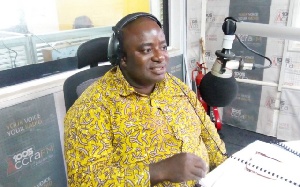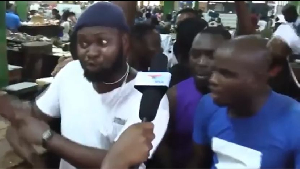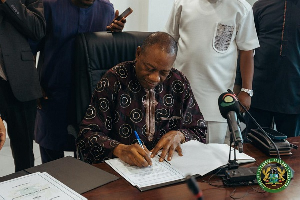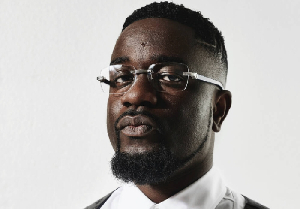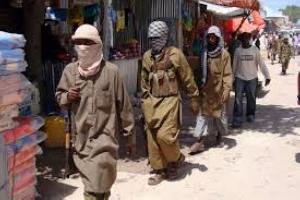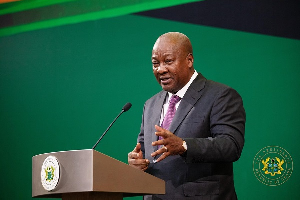By Leo Igwe
Witch sanctuaries, described by local NGOs as 'witch camps' form part of the infrastructure of witchcraft in Northern Ghana. These sanctuaries are shrines, though one of sanctuaries in Gushiegu is not attached to any shrine. Tindana are the heads of the sanctuaries. The Dagbani term, Tindana, literally means- the one who owns the land. They are responsible for consulting the Tindang, the community spirit or god whenever there is a problem like drought or epidemic, war, plague, accusations of death or illness witchcraft, etc
Bouiglana and Tingdana play similar roles in the local management of magic and medicine. Dagomba use both terms interchangeably to refer to shrine priests and local medicine men and women. From my own observations, Bouiglana are custodians of private gods or Bouigli. Bouigli means 'something which people worship' and believe could solve their problems. Bouigli are healers, consolers or problem solvers. They are translated as gods. These gods are localized and domesticated at shrines which people erect in their houses. Bouigli are many. They are always written in plural. The 'Bouigli gods' are different from the 'Naawuni God'. Naawuni is singular and refers to 'supreme deity'. Naawuni does not have a shrine and cannot be crafted and seen as in the case of Bouigli. Bouigli are smaller manifestation of the Naawuni. Dagomba can turn a lizard or crocodile into a Bouigli. People have clay pots as Bouigli.. They keep them in their houses and worship them . Dagomba sacrifice fowls and sprinkle blood on it. They pray to them and ask them for solutions to their problem. They buy cow milk and smear it on the pot. Tindang is a community spirit that is domesticated in a shrine. The Tindana are the physical custodians. Tindana and Bougilana are assumed to have extraordinary powers and can see what ordinary persons cannot see. When somebody is accused of witchcraft. It is the Bouglana or Tingdana who perform rituals to confirm if the accused is guilty or innocent. Apart from this ritual performance, Bouiglana or Tindana lead wars particularly very crucial wars because people believe that they have powers-supernatural powers to defeat the enemy. They have powers to ward off any calamity that befalls or could befall the village. For instance when there is drought, they normally come out, with fresh cow milk in a bigger calabash.They scoop the milk with a smaller calabash and pour it back to the bigger one in symbolic demonstration of rainfall. It is believed that such ritual would lead to cloud formation and rainfall. The Tindana or Bouiglana are assisted by other members of the priestly class in managing the shrines- conducting rituals and providing accommodation for accused persons who cannot return to their communities after the rituals. Tindana operate under the chief of the community, who are the political heads. At Gambaga, the structure is different. The chief - known as the Gambarana - is also the Tindana. Accused persons living in this sanctuary are only women, some of the women are living with their children or grand children. The inmates of the sanctuary in Gambaga come from the Dagomba, Konkomba, Bimoba and Mamprusi communities. The Kukuo sanctuary in Bimbillah is under a chief- the chief of Kukuo. Unlike the Gambaga camp, the Tindana is in charge of the sanctuary and performs the rituals associated with accusations of witchcraft. The sanctuary has only accused women, some of them live with their children or grand children. Accused persons are mainly Nanumba but there are few women from Dagomba, Konkomba and Katokoli-in Togo- ethnic communities. Kukuo is actually the only international witch sanctuary in the region. Accused persons live among the local population and include generations of accused women and their descendants. According to my informants, one way to differentiate the houses of accused persons from other members of the local community members is that accused persons live in single rooms while locals live in multiple room apartments.
I visited the witch sanctuary at Bonyase. It was recently closed down by the government. The Bonyase sanctuary is the least populated in the region. This sanctuary is unique because it is the only one in the region that had a female priest. The priestess is in her 70s. She took over the management of the shrine following the death of her father. This female Tindana used to be a bunisness woman living at the regional, Tamale. She was about to perform the muslim pilgrimage when the shrine chose her to succeed the father as the priestess. Apparently, the job of the community priestesse changed the course of her life and disrupted her growth and development as a muslim. As the Tindana of the community, she is not allowed to spend a night outside the community. All the accused persons at the Bonyase sanctuary were elderly women from the Dagomba and Gonja communities. There were no children in this sanctuary. There used to be some children at the shrine some years ago. When I inquired to know why there were no children staying with the women, I was told that the priestess did not allow families to bring children to come and stay with the accused. Four of the seven witch sanctuaries exist in Dagomba land. These are the sanctuaries in Gushiegu, Kpatinga, Nabuli and Gnani. All the accused persons at Gushiegu are female. The sanctuary is unique because it has no Tindana attached to it. No ritual is involved in the entrance and exit of alleged witches. An accused person who arrives the village reports to the chief who hands her over to the leaders of the women at the sanctuary. There are two sections of the sanctuary. There is the integrated sanctuary of accused persons who live amongst the local population and the non integrated sanctuary of the accused who live separately at a particular section of Gushiegu. This had nothing to do with the accusation. The non integrated witch sanctuary is a consequence of efforts by the local chief to contain the influx of accused persons to the community. The catholic church and some Non Governmental Organisations(NGOs)- Actionaid, Songtaba, Witch hunts Victims Empowerment Project (WHVEP) are active at this sanctuary. These groups have helped in refurbishing the houses, providing literary lessons to the women and children. Whenever possible, they facilitate the reintergration of those who are willing to go back to their families.The Gushiegu sanctuary has recorded a decline in the number of accused persons living there over the years.
The other two sanctuaries under Gushiegu districts- in Kpatinga and Nabuli are under the community chiefs. They are managed by a Tindana. The Tindana reports to the chiefs as the traditional protocol demands. The Tindana at Kpatinga sanctuary is in his 50s. He dropped out of school when he was in primary four and later took up the position of the Tingdana. He turns back any accused persons which came to the shrine without the family members. Accused persons pay the Tindana the sum of 100 Ghana cedis, a goat and two fowls. Sometimes he waives some of the items if the accused could not afford them. Any accused person leaving the shrine makes the same payments. Actionaid, Songtaba, Witchhunts Empowerment Project and the World Vision are active in the Kpatinga sanctuary. World Vision refurbished the houses of the alleged witches. WHVEP provides literacy programs to women and children in the camp.
The Nabuli witch sanctuary is latest of all. It started in the 90s. The priest in charge of the sanctuary is dead. A new Tindang has not been appointed. I was informed that the Dagomba-Konkomba war that took place in 1994 led to the formation of the sanctuary. During the conflict, accused women from the Konkomba ethnic group staying in sanctuaries located in Dagomba areas fled and settled at this site. This sanctuary in Nabuli is unique because it is the only one that is ethnically homogenous. All the accused persons come from the Konkomba ethnic group. During my conversation with the accused persons, some expressed willingness to return to their families. Actionaid, Songtaba, Witchhunts Victims Empowerment Project have support programs at Nabuli. I noticed little signs of the support programs at the Nabuli witch sanctuary as compared with other sanctuaries across the region. There were no houses with corrugated iron sheets no borehole or underground water tank as in the Gushiegu sanctuary. I think this is mainly due to accessibility. The Nabuli sanctuary is located in a very remote area. Most parts of road linking the Nabuli sanctuary and the Gushiegu town are still under construction or unmotorable. Gnani witch sanctuary is under Yendi district. It has a Tindana as well who works under a local chief. According to local legend, the first Ya-Na of Dagbon invited a priest to protect the kingdom (Actionaid 2008 p. 22). The priest gave him a magical stone which was kept in with a priest in Gnani.The location of this magic stone made Gnani a spiritually significant community and over the years a destination accused persons who are contesting the label applied to them Unlike other witch sanctuaries in the region, Gnani Tindang has accused persons from Dagomba and Konkomba ethnic groups. Gnani tindang is the only witch sanctuary that has male accused persons in the region.
I spent 8 days in May 2013 living at the sanctuary in Gnani. I observed how the accused go about their daily lives. I spent some time conversing with both the "witches" and "wizards" at the sanctuary. One of them is a middle aged man who confessed to being a wizard. He said some people in the community beat him terribly to the point that he had to admit to indulging in witchcraft so that they could leave him. He fled the community and took refuge at Gnani Tingdang. He has no plan of going back to his community. Another elderly man was too eager to reunite with the family members. He left them behind and was living alone at the sanctuary. He was banished for sickness witchcraft.- for making a child in the family ill using harmful magic. He denied the accusation and is looking for somebody who could help facilitate his return to the community. When I visted his villaga Bakpaba, some of the community members wondered why he wanted to return. They said the man had while he was the acting chief of the village expelled a woman who was accused of witchcraft and the woman was staying in the same witch sanctuary with him.
I met an elderly man in his 60s He is both a Bagha (soothsayer) and a Bouiglana. His case stands out because he continues with the job of divination and ritual sacrifice at Gnani. He fled his community and took refuge in Gnani sanctuary with his family after the brother accused him of attempting to kill him using magical means. The brother mobilize some people who brought him to the village square and flogged him. I asked him why he did not use his medicinal powers to cure the brother and neutralize the witchcraft. The man said the accusation had nothing to do with the health problem because the brother later recovered. That the accusation has to do with a local chieftaincy dispute. The brother wanted to be the chief of the village but it was not his turn yet so he used the accusation to get rid of him so that he could become the chief.
Some of the accused persons I met were willing to return to their communities but others were not. Some would prefer to relocate to another community because of the way they were disgracefully expelled. A few told me they would never return and would rather spend the rest of their life at the sanctuary at Kukuo. As the government of Ghana is working to disband the 'witch camps', it should seriously consider the role these sanctuaries play in providing a safety net for accused persons in the region.
Opinions of Thursday, 21 May 2015
Columnist: Igwe, Leo


